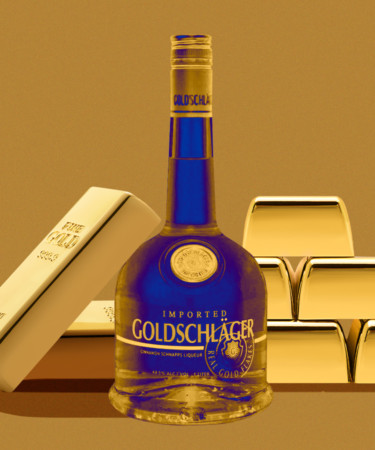Goldschläger, a sweet and syrupy cinnamon liqueur whose popularity peaked in the 1990s, is best known for its titular ingredient — flaked gold.
Swiss Goldschläger was Diageo-owned in the ‘90s, and the liqueur has since moved around the map quite a bit: Initially made in Switzerland, the spirit was briefly produced in Italy before returning to its native Swiss territory in 2008. The brand was purchased by beverage behemoth Sazerac in 2018 and is currently produced in Montreal. While Goldschläger is nowhere near as popular today as it was during its heyday, Sazerac released a 107-proof iteration of the spirit just last year, aptly named Goldschläger 107, an alternative to the original 87-proof offering.
When it was introduced to the American market, Goldschläger brought with it an air of intrigue around the gold not just in the bottle’s label and design, but the flakes that float in the spirit itself. Drinkers were attracted to its air of extravagance and tossed back shots of it en masse in bars across New York City, bartender Bo Wayne recalls to Wine Enthusiast. “There was a time where we were constantly doing shots of Goldschläger,” he says, calling NYC “the city of Goldschläger” at the time.
In the decades since, buzz around the liqueur has waned considerably, but its reputation as a spirit blessed with a Midas touch begs the question: How much gold is in Goldschläger, really?
The answer may be less than you think. New York-based gold refinery Manhattan Gold and Silver measured the gold content of the liqueur in 2010, extracting roughly .01 grams of the precious metal. According to a number of gold value calculators, that weight is worth less than one U.S. dollar ($0.62, to be exact). That means that gold accounts for a near-negligible proportion of the average $28 price tag on the schnapps.
All that glitters is not gold, and it appears that Goldschläger is no exception.
